Feeding the birds – winter.
Close encounters with birds.
If you really want to enjoy the birds close up there is nothing that beats feeding the birds. You get the birds so close you can study them with your bare eyes or take photos of them with you cell phone or a point and shoot camera.
Providing you have a place to put the feeder, here are some tips for the absolute beginner collected from my Facebook friends.
Type of feeders
It is important to keep the feeders clean. Make sure the seeds are kept dry and that there is good ventilation.
You can build your own feeders with some ingenuity or you can buy designed feeders. Some of my Facebook friends recommend some specific products below.
Home made feeders made of milk packages and soda bottles.
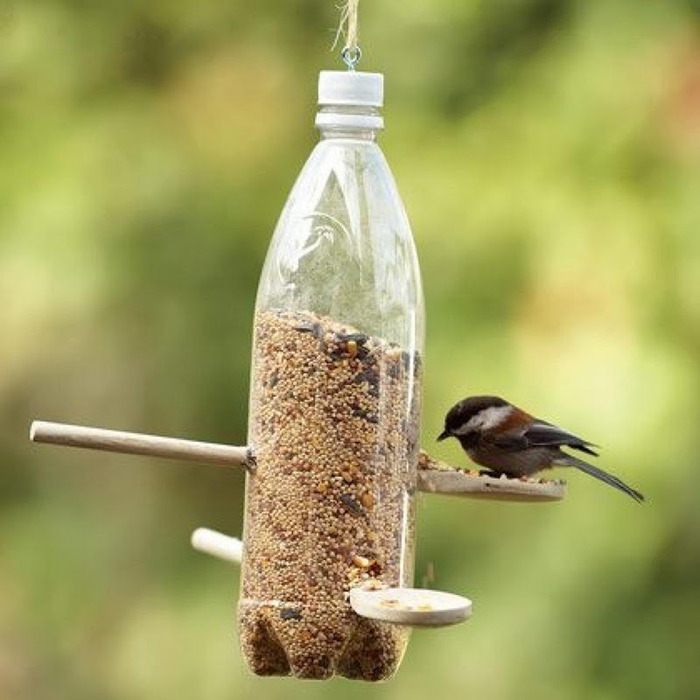
A clever soda bottle feeder with wooden spoons. See Spoonful.com for instructions how to build it.
Here is a video how to make a feeder from a milk package.
Here are 7 DIY Recylced Bird Feeders if you need more inspiration.
Hopper Feeders
A hopper feeder is a platform upon which walls and a roof are built, forming a “hopper” that protects seed fairly well against the weather,
less well against squirrels. They are fairly easy to build yourself. There are also commercially available ones that are designed to keep squirrels off such as those recommended below.
Gry Lockert-Andersen and Charles Swift recommend the Droll Yankees Hopper Feeder above.
Deborah Jean Cohen swears by Heritage Farms Absolute Squirrel Proof Bird Feeder (above). She has used it for years.
Squirrel Buster
Ingenious feeder Squirrel Buster to give the expensive seeds to the birds and not to the gluttonous squirrels.
David Graham’s neighbor and Janet Pawlusiak Pace recommend the Squirrel Buster. Janet says she has had hers for 6 years and it has performed very well.
Mesh Tube Feeder
These feeders are specifically good to keep the small Nyger seeds. There are plenty of models to choose from. This is just one Mesh Tube feeder I have found.
There are also mesh tubes for peanuts which will be very popular among woodpeckers. Here is a smart circular design for whole peanuts.
Suet Block Holder
Hanging the suet block you attract Woodpeckers and Nuthatches. Again there are many different models. This double suet block holder from the Stokes is Squirrel proof.
Tray feeder
Tray feeders are quite easy to put together by yourself. These feeders provide fast available food for a number of species. It is a good idea to have a roof so the seeds don’t get wet. It is also possible to put suet on the tray feeder. Depending on the design, the tray can either be placed on a pole or hanging from a tree.
Tray feeders tend to attract squirrels, so either you live with it or you prepare your feeder with a Squirrel Baffle.
It can also be an idea to put some food on the ground to attract such birds which keeps most of their time on the ground, such as doves, pheasants, quails, etc. If there is snow on the ground it is not a good idea to put bird food there, as it will be difficult for the birds to get to. Better to offer a ground feeder which could be a frisbee or a garbage can lid or you could buy a designed ground tray.
Birds seeds
When I was a kid we used to feed the birds bread, and yes the birds will eat that. But there is not much energy value in bread. Better to supply fat and protein rich seeds. Here are some seeds that are commercially available.
Sunflower seeds
Chickadees, Titmice, Nuthatches, Goldfinches, House Finches, Cardinals, Grosbeaks and Jays love sunflower seeds. The seeds come in two forms. Black oil sunflower seed is the most popular and have the high content of oil and a shell that is easy for the birds to open. The Striped form of Sunflower seeds have harder hulls.
Hulled Sunflower seeds are also available. Clean of the hulls it is less messy and easier for the birds to eat. The hulled seeds additionally attract Woodpeckers, Sparrows, Mockingbirds and Wrens.
Safflower
Safflower, are superficially similar to Sunflower seeds but white. Fewer birds eat them. The Starlings, Grackles and House Sparrows don’t like them. So if these birds are a problem in your area Safflower seeds could be away to avoid non-native birds. The Safflower seeds are particularly popular among the Cardinals.
Thistle Seeds
Also known as Nyjer or Nyger. These are thin black seeds imported from Africa and Southeast Asia. They are especially popular by clinging finches such as the Goldfinch, Common Redpoll and Purple Finch, as well as many of the other seed-eaters mentioned above. These seeds are high in oil, making them great for winter bird feeding. But they are small and very light, so they are easily spilled or blown away. Mesh-style or sock feeders are best for this expensive seed. Clinging birds will have no trouble feeding from these unique feeders.
Millet
Are small grainy seeds popular among ground feeders such as Sparrows, Doves and Juncos.
Corn
Whole or cracked placed near the ground for Pigeons, Doves, Quails, Pheasants, Towhees, Blackbirds, Grackles and Jays.
Nuts.
Peanut – unsalted of course – both whole nuts as well as peeled nuts. Most birds that eat hulled sunflower seeds eat nuts.
Fruit
Fresh fruit such as apples and oranges, is popular among Robins, Bluebirds and Mockingbirds. Baltimore Orioles are particularly fond of oranges. They also like dried fruits.
Mealworms
Many birds that eat insects, including titmice, chickadees, and
bluebirds, are attracted by mealworms. In the winter it is a good idea to mix mealworms in the suet. Buy Mealworms in pet stores.
Suet
Made from beef fat is very popular among nuthatches and woodpeckers. You can get unprocessed suet from the grocery store. There are also many packaged suet mixes available in bird food outlets. These suet mixes contain many types of seeds and other food items.
Claire Baker suggests that one may collect grease while cooking for home-made suet. Especially those “NuWave Convection ovens” with a grease collecting pan in the bottom. Collecting the grease and mixing it with peanut butter, cornmeal, oats, birdseed, raisins, leftover nuts, or whatever makes a great suet.
Claire writes: Then I put them in the plastic dishes that my chihuahua’s dog food comes in (Cesar’s) and wrap in plastic. This makes a small thing of suet (you could use plastic cat food dishes, be sure and wash them first), then I freeze them. Perfect for summer too. It doesn’t have time to spoil. The Golden-fronted Woodpeckers love the cold suet! So do the Green Jays and Great Kiskadees.
(Could you tell Claire lives in the Rio Grande Valley, Texas?)
In the next installment of Birding 101, my Facebook friend Deborah Jean Cohen in Pennsylvania provides a recipe of THE BEST SUET IN THE KNOWN UNIVERSE.
This sounds so cool, we just have to make a special post about it!
Bird Bath
Both Deborah Jean Cohen and Julia Lucignani insist that one of the most important items is a heated bird bath in the winter. It gives the birds both drinking water and a chance to keep their feathers clean. Commercial ones available include a bird bath that can be mounted on a porch and another larger 20 inch bird bath with stand. Another option is to just get a ice eliminator which you plug in and place in any bowl with water.
Identifying the birds.
In chapter 1 of Birding 101 there are a lot of tips for online resources how to identify birds. It is a good idea to try to get a photograph of the birds. Read Stephen Ingraham’s article how to choose a point and shoot camera for birding. Many of these models will get you excellent shots of the birds that come to your garden.
Spending money!
As I researched for this post I was amazed to see the commitment people have to feed the birds and the seemingly huge amounts of money involved doing so. There are clearly hoards of people out there who are willing to spend on bird seeds and designed feeders.
Facebook friend Jenny Graevell says: We go through about 2500 lbs of bird food a year. No 1 suet (homemade with suet, peanuts, peanut butter, flour, mealworms,) No 2 Black-oil Sunflower seeds, No 3 Thistle, No 4 Millet seed mix. No 5 MAINTENANCE! Clean those bird feeders at least monthly. Jane illustrates this commitment very well.
Feeding birds move a lot of money. Over 55 million Americans over the age of 16 feed wild birds and spend more than $3 billion a year on bird food, and $800 million a year on bird feeders, bird baths, bird houses and other bird feeding accessories
Now, think if some of these people could be tapped to also become members in bird conservation organizations such as the ABC. Or perhaps become members of local bird clubs or national organizations such as the ABA or National Audubon Society, which could do well with some more members to improve strained budgets.
Sources:
Below I have listed a number of sites I used to prepare this post.
- Janet Pawlusiak Pace supplied me with loads of info via her webpage resource Bird with me. Especially useful was the winter bird section.
- Cornell‘s excelent Feeding birds PDF prepares people to take part in Cornell’s feederwatch program. We introduce Feederwatch in the next chapter of this series.
- The Stokes‘s website provides a lot of good info. I used some info from the page on bird food.
- How to choose birdseeds from About.com
- Wikipedia. Bird Feeding
- Winter bird feeding tips by Carrol Henderson.
Finally, big thanks to all who have commented on my Facebook. They include: Martin Swanhall, Julia Lucignani, Deborah Jean Cohen, Andrew Haffenden, Janet Pawlusiak Pace, Jennie Duberstein, Claire Baker, Jenny Graevell, Gry Lockert-Andersen, David Graham, Charles Swift, Sherry Lidstone and Rob Alexander.
Additional tips.
What are your best tips for feeding birds in the winter in the US and Canada? Please use the comment section to let us know.
If you liked this post, please consider sharing it with your friends, on mailing lists you belong to, on Twitter, on Google+, on your Facebook wall, and on Facebook groups or you may blog about it. We need to get more people into caring about the birds. After all, with more people caring about birds and birdwatching becomes more significant, there will be more bird conservation. That can’t be bad.
Finally, subscribe to this blog, not to miss any future posts.
Disclaimer: All links to Amazon.com above are affiliate. That means if you click and buy, we earn a very small commission which helps to run this website, and help paying for the upcoming production of the eBook. You don’t pay any more, and we get a contribution. There will be no affiliate links in the ebook once it is ready. Thanks for your support.
Photos: White-breasted Nuthatch and Baltimore Oriole by Deborah Jean Cohen.
————————————————————————-
Gunnar Engblom
Connect with Gunnar on Facebook, Google+ or Twitter or kolibriexp@gmail.com.
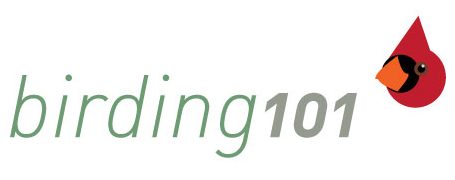
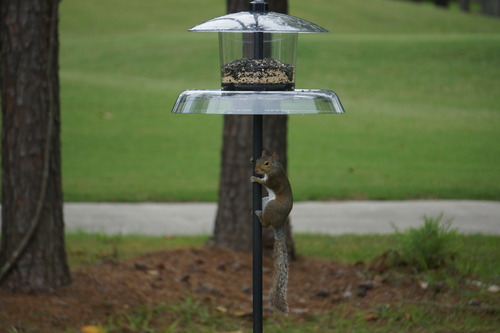
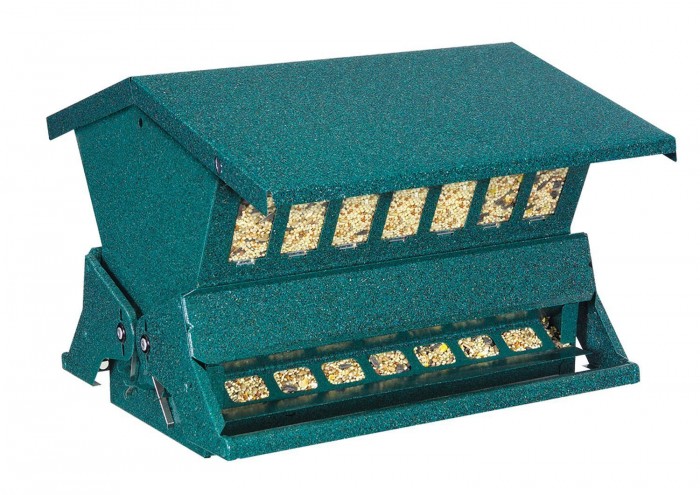
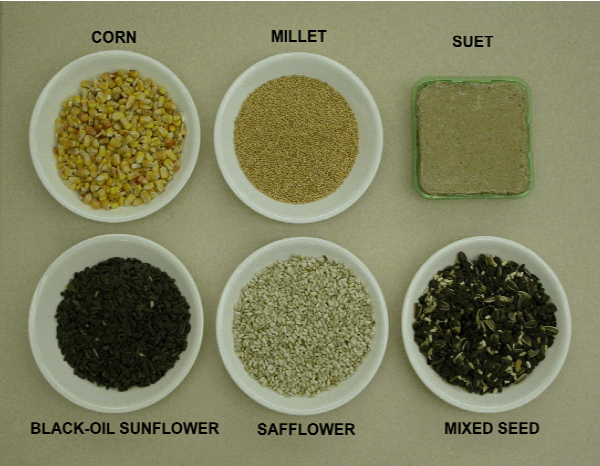
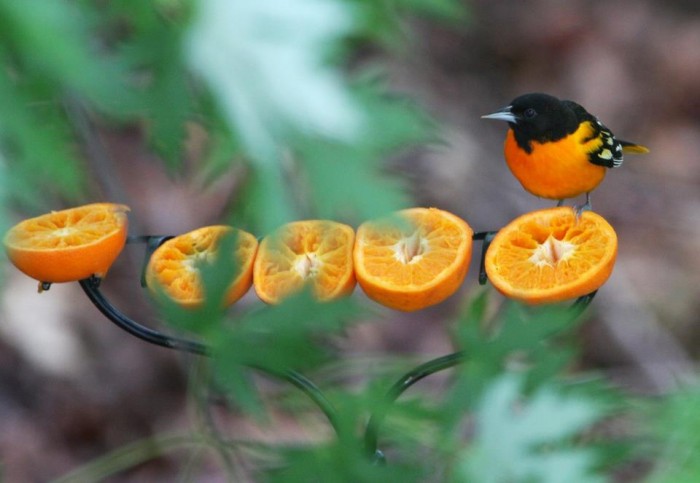
When I was living in Texas, I fed birds, but I also had cats. To avoid confrontations, I spread seed in the middle of my driveway. There were no trees or bushes for cats to hide in within at least 15 feet of the feeding spot. It worked very well. When hanging feeders, also be aware of seed that falls to the ground which will attract birds. If you have ground predators, hang the feeder high above a clear area without bushes for cats to hide in. I prefer hanging birdbaths. The birds can bathe without getting the attention of a cat on the ground. It’s also closer to limbs where it can perch, preen and dry off.
We had a bird feeder until the rats invaded, and I had to remove the feeder.
One night I heard squealing. There must have been 30 rats.
I love the birds and miss them. Is there any way to keep the rats away?
Thanks,
Martin
Petroleum jelly mixed with bitter apple spray or other bitter or supre spicy substance. Grease up the pole. You may have to apply every day if you say that many rats come to your feeder
Apply the grease to the pole thickly. The rats will slide down and get a taste of the nasty substance when cleaning their paws. eventually they will get disgusted and will leave it alone.